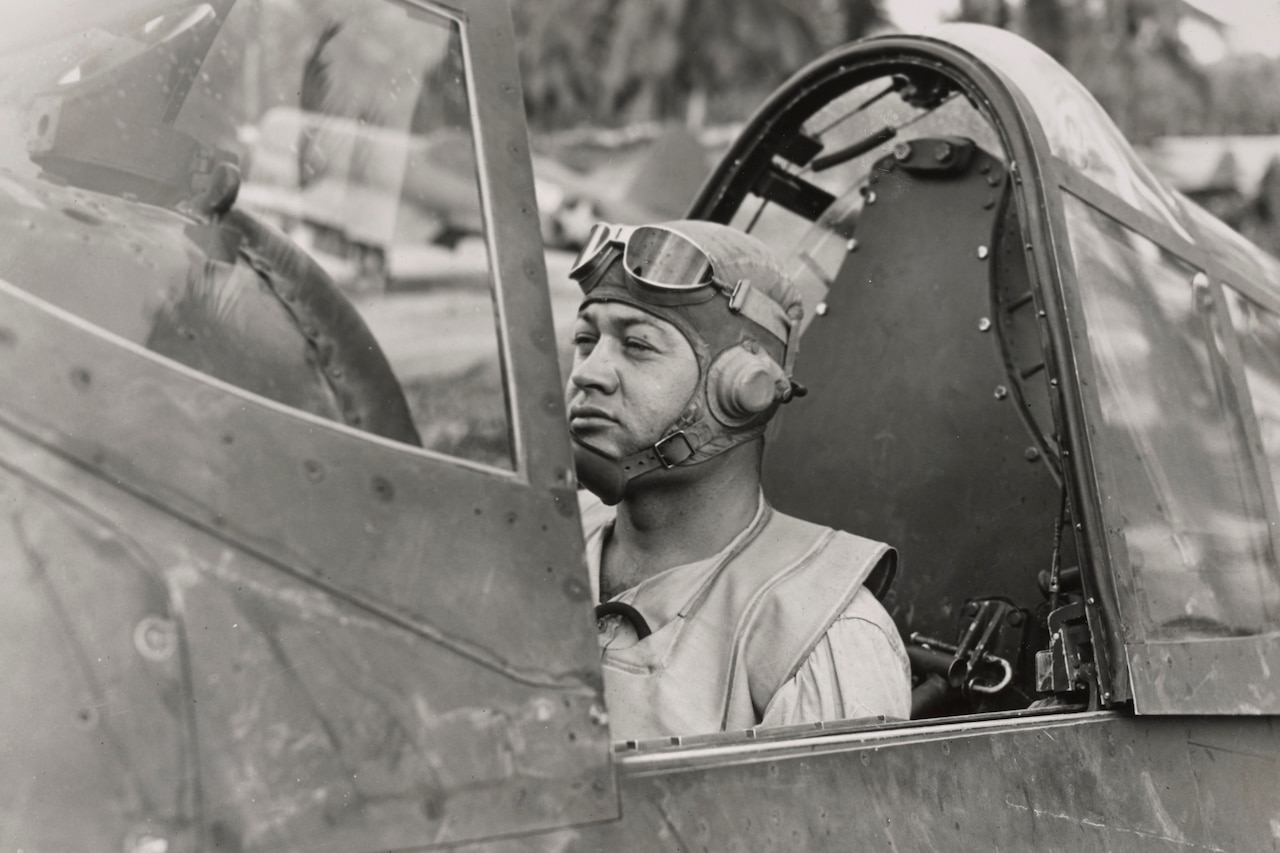Pappy Boyington
Marine Corps Colonel Gregory "Pappy" Boyington was one of the most decorated pilots in World War II. He is best known for leading the Black Sheep Squadron, a group of misfits and rogues who became one of the Marines' most feared and respected units. Pappy was a larger-than-life figure, and his story is one of courage, determination, and patriotism.
In this post we'll discuss his impressive career as a fighter pilot in World War II and explore his honors. So without further ado, let's get started!
Earlier Life
Pappy was born on December 4, 1912, in Coeur D'Alene, Kootenai County, Idaho, United States. At the age of three, he cruised with his family to St. Maries, a bustling logging town, where he lived until age 12. Then they pushed on to Tacoma, Washington, where he stood out as a wrestler at Lincoln High School.
He made his maiden flight with Clyde Pangborn at St. Maries at the small age of 6. For those who don’t know, Clyde Pangborn was the first pilot to make a non-stop flight over the Pacific Ocean—a fitting start for a boy destined to take to the skies.
Pappy graduated from high school in 1930 and went on to the University of Washington in Seattle. There, he became a constituent of the ROTC Army and got hooked into the Lambda Chi Alpha community. He joined the hoarse wrestling and swimming groups, at one point claiming the Pacific Northwest Intercollegiate middleweight wrestling title. Summers were spent sweating in a mining camp in Washington or building roads with the Fire Protective Association in Idaho. By 1934, he had earned a bachelor’s degree in aeronautical engineering. After graduation, Gregory Boyington married and worked as a draftsperson and engineer for Boeing in Seattle.
Died: January 11, 1988, Fresno, California, United States
Military Career
Boyington began his military journey in college as a member of the ROTC Army, even rising to cadet captain. In June 1934, he was commissioned as a second lieutenant in the Artillery Reserve of the U.S. Army Coast, serving with the 630th Coast Artillery and completing two months of active duty at Fort Worden, Washington.
In 1935, he set his sights on flight training as an Aviation Cadet, but hit a snag—married men weren’t eligible. Boyington, raised as Gregory Hallenbeck, had long believed his stepfather, Ellsworth J. Hallenbeck, was his biological father. That changed when he received a copy of his birth certificate and learned his true father was Charles Boyington—his parents had divorced when he was a newborn.
Interestingly, there was no record of Gregory Boyington ever being married in military files, and he enlisted as an aviation cadet in the U.S. Marine Corps under that name.
U.S. Marine Corps Career
On June 13, 1935, he transferred to the U.S. Marine Corps Reserve, then was placed on inactive status on July 16. By February 18, 1936, Gregory Boyington had been selected as a flying cadet in the Marine Corps Reserve, heading to Naval Air Station Pensacola for flight training. He was released from the Marine Corps Reserve in July 1937 to accept a second lieutenant’s commission in the Marine Corps.
Boyington attended The Basic School from July 1938 to January 1939 in Philadelphia. He participated in fleet problems aboard the aircraft carriers USS Lexington and USS Yorktown. After promotion to first lieutenant in November 1940, he returned to Pensacola as an instructor in December.
:quality(70)/arc-anglerfish-arc2-prod-mco.s3.amazonaws.com/public/KQL5TV6S5JBURDHB73MWZ7RYQU.jpg)
Return To The Marine Corps
On September 29, 1942, he rejoined the Marine Corps as a major. The Marine Corps, in need of seasoned combat pilots, assigned him at the start of 1943 to Group 11, 1st Marine Aircraft Wing.
While assigned to VMFA-122, Greg Boyington did not shoot down any enemy aircraft. From July to August 1943, he commanded Marine Fighter Attack Squadron 112.
- He became commanding officer of Marine Fighter Squadron 214 (VMF-214) in September 1943—better known as the "Black Sheep Squadron."
- During intense operations in the Russell Islands and Bougainville–New Britain–New Ireland areas, he downed 14 enemy fighter planes in just 32 days.
- By December 27, 1943, his tally had reached 25. Boyington was a determined fighter and an exceptional pilot, known for his daring heroism and leadership.
- Among his many feats was the raid on Kahili airfield at Bougainville’s southern tip on October 17, 1943. Leading 24 pilots, he circled the heavily fortified area, drawing out 60 enemy aircraft and provoking a massive aerial engagement.
- In the fierce dogfight, 20 enemy aircraft were shot down, with the Black Sheep returning safely to base—no losses.
- Japanese forces were repeatedly outmatched by Boyington and his squadron, their “flying tigers” proving unstoppable in the South Pacific.
- On January 3, 1944, he tied World War I ace Eddie Rickenbacker’s record of 26 aerial victories before being shot down.
- On that mission, 48 American fighter pilots, including four from the Black Sheep Squadron, swept over Rabaul, with Boyington leading the formation over the target at 8:00 AM.
He was seen shooting down his 26th plane but got caught up in the chaos of battle—disappearing from view and failing to return with his squadron. In later years, Masajiro "Mike" Kawato claimed to have shot him down, describing the encounter in books and interviews, though this was ultimately disputed. Regardless, Boyington’s disappearance marked the end of his combat flying days.
Post War Active Duty
Soon after returning to the U.S. As a lieutenant colonel, Boyington was summoned to Washington to receive the nation’s highest military honor—the Medal of Honor—from the President. The award had been approved in March 1944 by the late President Franklin D. Roosevelt and held in the capital until Boyington could receive it in person. On October 4, 1945, he also received the Navy Cross from the Commandant of the Marine Corps.
Following these honors, Boyington led a Victory Bond Tour and was assigned to Marine Corps Schools, Quantico, and later to Marine Corps Air Station Miramar in San Diego, California. He retired from the Marine Corps on August 1, 1947, recognized for his distinguished combat service and promoted to colonel.
Later Life of Pappy Boyington
Boyington was a rough, hard-living character, known for being unconventional. He struggled with alcoholism after the war, which contributed to several divorces. He often joked that his health actually improved during his two years as a prisoner of war due to enforced sobriety. He held various civilian jobs, including refereeing and participating in professional wrestling matches.
Greg Boyington authored his autobiography, Baa Baa Black Sheep, published in 1958. He also wrote a story about the American Volunteer Group (the Flying Tigers), and even penned a spy novel featuring characters based on real people—often with their names cleverly disguised by syllable reversal.
Medal of Honor Accreditation
Gregory Boyington's Medal of Honor was accredited to Pierce County, Washington, specifically his hometown of Tacoma. Following the ticket of his Medal of Honor and Navy Cross, Boyington created a Victory Bond Tour. Initially called to the Marine Corps Schools, Quantico, he was subsequently directed to declare to the commanding general, Marine Corps Air Station, California, Miramar, San Diego. He got retired from the Marine Corps on August 1, 1947. He was especially praised for the performance of duty in a real war; he was stimulated to colonel.
Where Is Boyington’s Medal of Honor Now?
For those wanting to see a piece of history up close, Gregory "Pappy" Boyington’s Medal of Honor is proudly displayed at the Marine Memorial Club in San Francisco, California. This fitting location honors the enduring legacy of Boyington’s service and heroism, offering visitors a unique glimpse into the bravery of the Black Sheep Squadron's legendary leader.

Pappy Boyington Quotes
As Boyington also served as an author, he left behind many memorable sayings. Some of them are given below:
- “Chesty Puller told me* years ago, and there is only a hairline’s difference between a Navy Cross and a general court-martial.”
- “I have never been brave, but most of the things for which I had been given credit for bravery were nothing but daredevil stunts. I was trying to build up my ego, imitating the bravery of people I had read about or had been told about in the years gone by.”
- “A word of advice to you men. Many times in your Marine Corps career, you feel like resigning. But don’t forget: one son of a bitch or four or five cannot ruin the Corps.”
- "Show me a hero, and I will show you a bum"
Do check out our Pappy Boyington Vintage Aviation Sign for Home or Pilot Club, a homage to one of the greatest fighter pilots ever.
Conclusion
In the end, Gregory Boyington was a hero not just because of his impressive record in combat but also because of his ability to overcome adversity and inspire others. He was a courageous pilot who never gave up, even when the odds were stacked against him. His heroism and dedication will continue to inspire many people for years to come.
Thanks for following along on this journey through the life of Greg Boyington. We hope you’ve enjoyed it as much as we have. As you may have noticed we at ASJ are huge fans of Pappy Boyington and his contribution to aerial forces during the war.
Today’s aviators know little about these kind of men and how they have stood out and increased combat readiness of today’s military. A lot of information has been gathered and used to improve combat and combat readiness in heavily defended hostile territory as we know it today in a vitally strategic area, along with his record of destroying Japanese aircraft.
Over the course of time, there certainly has been no one that has been so influential in fighters shot as well as a very unique commanding officer. Pappy Boyington was buried in Arlington National Cemetery in 1988.
Aircraft
F4U Corsair


P-40










